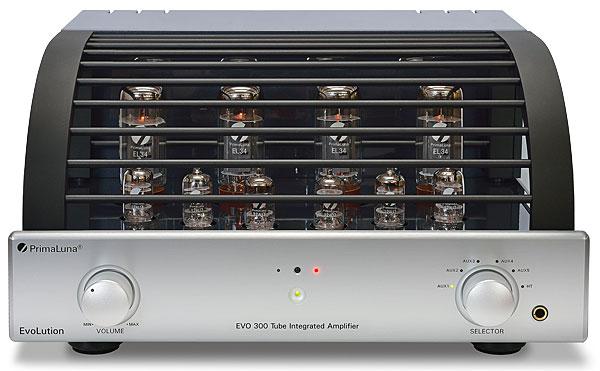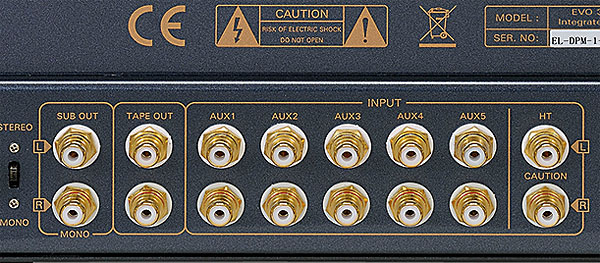PrimaLuna EVO 300 Integrated Amplifier

 For the inveterate enthusiast, PrimaLuna continues its tradition of user-tweakable amplifiers with the EVO 300, an ode to tube traditions – but with modern surprises
For the inveterate enthusiast, PrimaLuna continues its tradition of user-tweakable amplifiers with the EVO 300, an ode to tube traditions – but with modern surprises
It's important to accept how language evolves, particularly when reviewing an amplifier with a name that is a contraction of 'evolution'. PrimaLuna calls its current lineup EVO, as it represents the next step in the advancement of its valve amps, and the 40W-rated £3798 EVO 300 integrated represents the mid-point in a 13-model range. This is a line-only model, available in gloss black or silver, but with a £170 MM phono stage module that can be retro-fitted into an enclosure under the main chassis (not fitted to our sample). Of course, enthusiasts have plenty of alternatives here with the likes of Thorens' MM-008 [HFN Feb '21] costing only £220 and offering both MM and MC inputs.
A fine headphone amp is built-in, a switch on the right selecting headphone or speaker output, the latter via 8ohm and 4ohm transformer taps. As for 'digital', the EVO 100 DAC [HFN Jun '20] exists because founder Herman van den Dungen believes integrated DAC solutions swiftly become obsolete. 'This would cause the re-sale value of the amp to crash', he says.
Feature Feast
All the EVO 300 lacks is balanced inputs, which you do get with the EVO 300/400 power amps and the EVO 400 preamp [HFN Apr '20]. Otherwise, it's a feast of features. PrimaLuna uses costly point-to-point wiring, socketry is top quality, and operation is self-explanatory, save for the 'high bias' and 'low bias' switch on the right side. 'High' is selected for KT120s and KT150s, 'Low' for EL34s, KT88s, etc. Apart from niceties like remote control and slick auto-biasing, this would not baffle an audiophile circa-1965 who had been plucked from a listening room and transported to 2021.

What makes PrimaLuna's philosophy a joy for tweakers starts with the mono/stereo switching to be found on the amp's rear panel. The EVO 300 can be turned into a monoblock when upgrade-itis hits; one just adds an EVO 300 power amplifier. If both are left in stereo mode, they would suit true bi-amplification.
Next – and I loved this, as one who often needs to try both – the remote does more than level and source setting: it enables the luxury of comparing the sound of triode and ultralinear modes from the hot seat without first reaching for the volume control. You'll hear a small gain in level with the move from the former to the latter, and the two deliver the signature sounds of each type – old hands know what to expect. PrimaLuna's 'Adaptive AutoBias' facility, though, is the most important feature regarding owner liberation, making this a dream for the perpetually curious.

Roll Call
EVO amps can deal with any of the these without the need of an AVO meter: 6L6G, 6L6GC, 7581A, EL34, EL37, 6550, KT66, KT77, KT88, KT90, KT120 and the latest KT150. (The EVO 100 integrated cannot accept KT150s.) For the review, we stayed with EL34s.
It takes around a minute from switch-on for the red LED to change to green, leaving mute mode. LEDs above it glow green or red for ultralinear or triode, visible from across the room, so if you don't trust your ears, you will still know which mode you're in. The level change is not as great as you might think, but I doubt you'd miss it. Even with conservatively-driven EL34s the EVO 300 had no trouble driving LS3/5As, Magnepan's hungry LSR panel, or Quad's S1. What the option to fit other valves provides, in addition to the prospect of more power, is a very neat way to fine-tune the sound to suit one's tastes.
![]() Blast From The Past
Blast From The Past
Even from cold, the EVO 300 sounds cuddly and non-aggressive. It delights me to report that the experience with EL34s was akin to finding a virgin Radford STA-25 or Dynaco Stereo 70, both of which used that valve. Those with a taste for higher-powered American amps would need no encouragement to try this with 6550s or KT88s to emulate a McIntosh MC275. My own observations confirmed that the EL34s in the EVO 300 retained all the familiar traits. Christine McVie's voice throughout Fleetwood Mac's box set 1969-1974 [Warner/Reprise R2 5960060] enjoyed a gorgeous liquidity which pegged that tube's nature to perfection. The EL34's bass was more rounded than the snappier sound of a KT88 or, even more so, a 6550.
Listening to Mick Fleetwood's powerful drumming on the live version of 'Black Magic Woman/Oh Well' on the box set's live CD from 1974, the EVO 300 created a massively wide soundstage, his percussion panning across the front of the listening room. Stage depth was exceptional, wall-to-wall and especially convincing with the astonishing Broadway recording of Fiddler On The Roof [RCA FTO-5032; open-reel tape]. Here 'stage depth' has real meaning: the air and space recreated by the EVO 300 transforming the listening room into a facsimile of a real theatre. And you could even hear footfalls.

























































